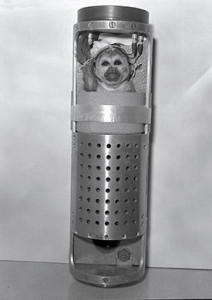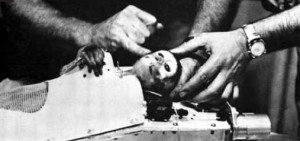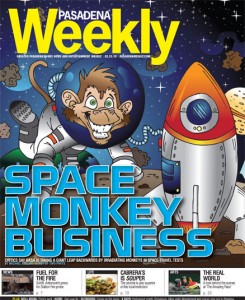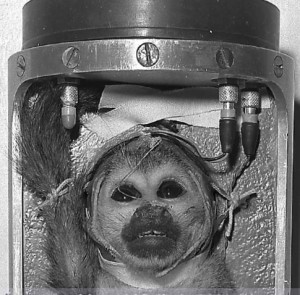By Michael Collins – First of two parts
Pasadena Weekly cover story “Space Monkey Business” with the cover art.
READ our questions for squirrel monkey radiation experiment project head, McLean Hospital’s Dr. Jack Bergman, and the hospital’s response in “Space Monkey Business Q & A.”
SEE the People for the Ethical Treatment of Animal’s petition page asking NASA not to experiment on the squirrel monkeys in order to gauge radiation’s effects on humans in space.
SEE the Physicians Committee for Responsible Medicine petition page asking NASA Administrator Charles Bolden, Jr. to stop the use of monkeys in space radiation studies.
SPACE MONKEY BUSINESS
Critics say NASA is taking a giant leap backwards by irradiating monkeys in space-travel tests
Pasadena Weekly – February 25, 2010
The future of manned space exploration was revealed Feb. 1 when President Obama unveiled his 2011 budget request for NASA. The president proposed ending the Constellation program, an initiative introduced by President Bush in 2004 to take Americans back to the moon by 2020 and to Mars beyond.
Obama’s grounding of the manned space program has unleashed a torrent of criticism that could gut the move to prioritize robotic missions and technological advancements rather than planting flags on the moon. Nowhere will the impact of how the great space debate plays out be more pronounced than at Pasadena’s Jet Propulsion Laboratory.
But far from JPL, 18 sociable monkeys sit in cages at the NASA Space Radiation Laboratory in Upton, NY, where they will be injected with gamma radiation by scientists who contend that the results can be correlated to humans facing long outer space flights through fields of intense cosmic radiation.
The budget’s approval by Congress will determine the future of these squirrel monkeys in the $1.75 million experiment to see how much radiation the critters can take. Animal testing of this sort hasn’t been done in nearly three decades. While officials maintain they will follow all institutional, state and federal guidelines in caring for the monkeys, some animal rights groups are outraged.
“NASA prides itself on looking to the future, but when it comes to crude and cruel animal experiments, the agency is stuck in the Dark Ages,” said People for the Ethical Treatment of Animals Vice President of Laboratory Investigations Kathy Guillermo in a statement on PETA’s Web site. “Monkeys are highly social, sensitive and intelligent animals. Harming them in experiments so that NASA can check off another item on its seemingly endless list of questions about outer space is unjustifiable, especially when modern, humane research methods exist.”
Radiation overload
The monkeys are a small but important cog in determining the future of the space agency, now that Obama has proposed ending manned space flight to the moon and Mars. Critics contend that the astronomical amounts of money saved from trying to ferry humans to outer space will result in better and more robust robotic exploration of the heavens. Supporters of Constellation counter that it has already cost $9 billion, which would be wasted along with the $2.5 billion more it will cost to shutter the program, throwing thousands out of work in the process.
President Obama has a fight on his hands with Congress over this radical departure from NASA’s focus. Last year, lawmakers made cutting Constellation programs subject to their approval. That provision sent a “direct message that the Congress believes Constellation is, and should remain, the future of America’s human space flight program,” wrote Sen. Richard Shelby, R-Ala., in December.
America’s manned space program is at a crossroads. Most if not all NASA missions can be completed robotically, leaving Constellation supporters with the main argument that human exploration inspires the nation. That powerful notion worked during the Cold War, but may not now, considering the astronomical cost of keeping people alive in the forbidding environment of space.
The monkeys’ fate, however, may lie in information the Pasadena Weekly found, which NASA has either missed or ignored: Italian experiments on the International Space Station involving astronauts wearing special helmets to measure cosmic radiation exposure, which seem to obviate the need to nuke the monkeys.
Even with remarkable technological advancements since NASA’s outer space heyday of the Apollo program, one of the only known ways to protect against this kind of radiation is still lead shielding. The heavy metal would be required in spacecraft and astronauts’ suits and would render spacecraft and astronauts too heavy to be practical for long space flights.
The National Research Council cautioned in early 2008 that present technology to protect against space radiation “would not allow a human crew to undertake a Mars mission and might also seriously limit long-term moon activity.”
Cosmic rays consist of high-energy protons and other nuclei so intense that the Apollo astronauts reported seeing flashes in their eyeballs. The 24 astronauts who made up the Apollo program, the only men ever to have gone into deep space, are too small a number statistically to be scientifically representative, but it is thought that they have suffered an above-normal rate of cancer.
Plus, the longest flight the Apollo astronauts rode on was less than two weeks, not the months needed to travel to Mars.
Estimates of radiation exposure in outer space do exist. An unshielded interplanetary astronaut would receive about 400 to 900 milli-Sieverts (mSv) annually, compared to 2.4 mSv on Earth. Even a “shielded” mission to Mars lasting 30 months would irradiate humans with up to 1,000 mSv (1 Sv), which is approaching the lifetime limit, 1 to 4 Sv, advised for so-called “low-Earth orbit activities” of astronauts, as determined by the National Council on Radiation Protection and Measurements.
To be totally effective against both galactic cosmic rays and higher energy waves, any known shielding would weigh hundreds of metric tons. Even that shielding can cause reflective “bounce back” or secondary radiation exposure. The radiation in outer space is intense, especially during solar proton events when the sun emits a solar flare or coronal mass ejections.
Irradiating 18 squirrel monkeys to test their cognitive responses suggests that NASA knows it won’t be able to adequately shield astronauts living on the moon and traveling to and from Mars. If the monkeys perform effectively even after being dosed with a massive shot of gamma radiation, the argument could be made that humans could do the same.
‘Pretty much on target’
In the study, the monkeys will be shot up with a single substantial dose of gamma radiation, which NASA’s project leader, Dr. Jack Bergman of Harvard Medical School’s McLean Hospital near Boston, insists would simulate what a human would receive over the 130 to 260 days it would take to travel to and explore the Red Planet.
“We realized there was a need for this kind of work,” Bergman told Discovery News reporter Irene Klotz for an Oct. 29 article titled “NASA To Start Irradiating Monkeys — Spider monkeys will be exposed to regular, low dose radiation as NASA investigates the effects of long term space travel.”
“There’s a long-standing commitment on the part of NASA to deep space travel and with that commitment comes a need for knowing what kinds of adverse effects deep space travel might have, what are the risks to astronauts,” Bergman continued. “That’s not been well-assessed.”

Along with confusing spider and squirrel monkeys, the subheadline of the article is inaccurate in two significant ways: the monkeys won’t be exposed to “regular” radiation, but rather one massive gamma radiation injection, and the radiation is not “low dose,” as the dose is supposed to simulate months worth of “HVE,” or high energy particles of high atomic number, that people exploring the moon or traveling to Mars would experience zipping through them.
Bergman’s statement that the risks to astronauts have “not been well-assessed” is also suspect. The risks have been assessed and they are significant. President Bush stated this when he announced the initiative.
Another article for Discovery News penned five months earlier by the same reporter, titled “Space Torso Reveals Cancer Risk for Astronauts,” says, “‘The information collected so far confirms that NASA’s current guidelines for assessing radiation risks are pretty much on target,’ said Francis Cucinotta, a doctor and researcher who heads radiation studies at the Johnson Space Center in Houston.”
So if the risk assessments are “pretty much on target,” why would NASA spend $1.75 million on Bergman’s experiments to nuke 18 squirrel monkeys? The answer may lie in a passage later in the article: Cucinotta figures the agency has about five years to come up with some solutions to the radiation problem or find evidence that refutes current assessments of the risks (our emphasis). More shielding on moon and Mars ships probably isn’t the answer, Cucinotta told Discovery News. The additional weight would make the spacecraft too heavy to launch with today’s technologies.
That evidence could be obtained by showing that the monkeys essentially shake off the radiation and continue to perform tasks effectively, since shielding and gene-repairing pharmaceuticals seem out of the question.
“We’d all be cured of cancer on Earth if we knew how to do this,” Cucinotta told Discovery News of the use of drugs to diminish radiation damage. No pill can stop deadly radiation from destroying human and monkey cells.














Recent Comments